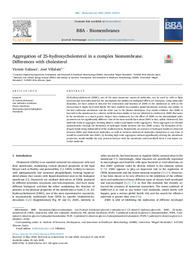Por favor, use este identificador para citar o enlazar este ítem:
https://hdl.handle.net/11000/30424Registro completo de metadatos
| Campo DC | Valor | Lengua/Idioma |
|---|---|---|
| dc.contributor.author | Galiano, Vicente | - |
| dc.contributor.author | Villalaín, José | - |
| dc.contributor.other | Departamentos de la UMH::Ingeniería de Computadores | es_ES |
| dc.date.accessioned | 2023-12-19T09:58:33Z | - |
| dc.date.available | 2023-12-19T09:58:33Z | - |
| dc.date.created | 2020-07 | - |
| dc.identifier.citation | Biochimica et Biophysica Acta (BBA) - Biomembranes Volume 1862, Issue 11, 1 November 2020, | es_ES |
| dc.identifier.issn | 0005-2736 | - |
| dc.identifier.uri | https://hdl.handle.net/11000/30424 | - |
| dc.description.abstract | 25-Hydroxycholesterol (25HC), one of the most important oxysterol molecules, can be used by cells to fight bacterial and viral infections but the mechanism that defines its biological effects are unknown. Using molecular dynamics, we have aimed to describe the orientation and location of 25HC in the membrane as well as the interactions it might have with lipids. We have studied two complex model membrane systems, one similar to the late endosome membrane and the other one to the plasma membrane. Our results reinforce that 25HC is inserted in the membrane in a relative stable location similar to but not identical to cholesterol. 25HC fluctuates in the membrane to a much greater degree than cholesterol, but the effect of 25HC on the phospholipid order parameters is not significantly different. One of the most notable facts about 25HC is that, unlike cholesterol, this molecule tends to aggregate, forming dimers, trimers and higher-order aggregates. These aggregates are formed spontaneously through the formation of hydrogen bonds between the two 25HC atoms, the formation of hydrogen bonds being independent of the studied system. Remarkably, no contacts or hydrogen bonds are observed between 25HC and cholesterol molecules, as well as between cholesterol molecules themselves at any time. It would be conceivable that 25HC, by forming high order aggregates without significantly altering the membrane properties, would modify the way proteins interact with the membrane and henceforth form a true innate antiviral molecule. | es_ES |
| dc.format | application/pdf | es_ES |
| dc.format.extent | 11 | es_ES |
| dc.language.iso | eng | es_ES |
| dc.publisher | Elsevier | es_ES |
| dc.rights | info:eu-repo/semantics/openAccess | es_ES |
| dc.rights.uri | http://creativecommons.org/licenses/by-nc-nd/4.0/ | * |
| dc.subject | 25-Hydroxycholesterol | es_ES |
| dc.subject | Late endosome membrane | es_ES |
| dc.subject | Plasma membrane | es_ES |
| dc.subject | Bis(monoacylglycero)phosphate | es_ES |
| dc.subject | Cholesterol | es_ES |
| dc.subject.other | CDU::6 - Ciencias aplicadas::62 - Ingeniería. Tecnología | es_ES |
| dc.title | Aggregation of 25-hydroxycholesterol in a complex biomembrane. Differences with cholesterol | es_ES |
| dc.type | info:eu-repo/semantics/article | es_ES |
| dc.relation.publisherversion | https://doi.org/10.1016/j.bbamem.2020.183413 | es_ES |

Ver/Abrir:
Aggregation of 25-hydroxycholesterol in a complex biomembrane. Differences with cholesterol.pdf
4,09 MB
Adobe PDF
Compartir:
 La licencia se describe como: Atribución-NonComercial-NoDerivada 4.0 Internacional.
La licencia se describe como: Atribución-NonComercial-NoDerivada 4.0 Internacional.
.png)